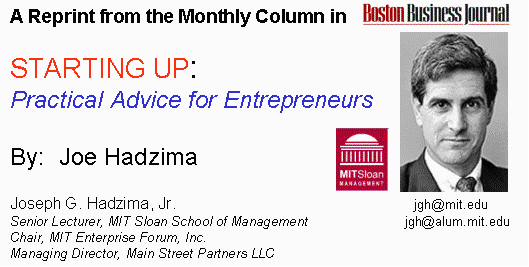

How Much Does An Employee Cost?
(Click Here for a PDF Version of This Article)
Employment costs fall into several broad categories:
Recruiting Expenses.
Finding technically qualified people who can function effectively in a rapidly growing start up venture is not easy task. In an earlier column we discussed the economic alternatives for head hunting. For this column it suffices for me to remind you to be sure to devote the time to make sure that your hires are as close to perfect “10s” as possible. Anything less will be a drag on your business.
Basic Salary.
Basic salaries vary all over the place depending on the industry and a variety of other factors. There are data that can help you calibrate an appropriate base salary. For example, the Massachusetts Software Council puts out an annual Compensation Survey and there are similar publications in other industries. Be sure to establish rational salary ranges given your growth plans. This means that in most cases there should not be great salary differentials between early hires and later employees- any "risk component" of being an early hire should be made up in the equity compensation component.
Employment Taxes.
In preparing your personnel budget be sure to include allowances for Social Security/FICA (currently 6.2% on the first $90,000 of salary – www.ssa.gov), Unemployment/FUTA (6.2% on $7,000 of salary - http://workforcesecurity.doleta.gov/unemploy/uitaxtopic.asp) and Medicare (1.45% with no salary cap – www.ssa.gov). Workmen’s compensation premiums will depend on the category of your employee, with clerical at about 0.3% of salary and manufacturing at 7.5%.
Benefits.
Basic salary and employment taxes are a minimum- in most cases you will need to provide some benefits. Typical benefits for a $50,000 salaried employee include life insurance ($150) and health coverage ($2,000-$3,000 for single persons; $6,000-$7,2000 for families - http://www.ahrq.gov). Other benefits could include long-term disability insurance ($250), dental plans ($240-$650), dependent care assistance, tuition reimbursement, retirement plans etc. These involve actual payment of benefits by the employer. There are also "self funded" plans where the employer contribution is the administrative costs- e.g. 401(k) savings plans where a portion of the employee’s salary is withheld. Vacation is another cost but is subsumed in the basic salary.
The costs to this point (basic salary, employment taxes and benefits) are typically in the 1.25 to 1.4 times base salary range- e.g. the cost range for a $50,000/year employee might $62,500 to $70,000.
Space.
Unless you are hiring traveling salespeople, you need to provide some physical space to house the new employee. Obviously the rent per square foot varies depending on the fanciness and location of the facility. But how many square feet does an employee need? Again this varies but there are some guidelines. Work cubes are typically 8' x 8' in size and private offices range in size. In high tech figure on 225 to 250 square feet per employee when you add in common space. Furnishing the space, even with used work cubes will probably run $2,000 at a minimum.
Other Equipment.
The basics these days for high tech or office workers have to include a computer and telephone. Even with decreases in PC prices, figure on $1,000+ for a computer, $500 to several thousand for software and $250 to $300 initially per telephone handset on average when you factor in installation. Don’t forget the periodic expensive upgrades you will need to your LAN and voice mail systems.
Other Approaches.
Instead of figuring out each cost component separately you can develop some simple metrics. For example, one entrepreneur I talked to is in the engineering services business in which his people are billed on projects on a time and materials basis. The entrepreneur takes the employee’s base salary and multiplies it by 1.25 to cover employment taxes and benefits. She then multiplies that number by 1.75 to cover rent, equipment etc. Because some management personnel are needed and some of the employee time is spent in non-billable technology development, she multiplies that number by 1.25. She figures that for her professional engineering consulting business the fully functioning managed employee costs about 2.7 times the base salary. She has a different metric for planning the manufacturing side of her business. In both cases even though the metrics are simple and easy to apply it has taken her some time to really understand the cost components of her business segments in order to develop the metric. She notes although that her "rule of thumb" is helpful in planning rapid growth, like any rule of thumb the underlying assumptions need to be recalibrated periodically.
Hiring is always a difficult and important activity, especially in a rapid growth business. There is always too much to do and often the new entrepreneur has little experience in hiring. It is the rare case when you can hire exactly to meet your needs. Delay in hiring and you will have trouble meeting your plan, hire too quickly and you may burn through cash before revenue catches up. Consider using independent contractors to cover peak periods if your business does not have too steep a learning curve. One of my clients staffs at 85% of forecasted needs and contracts out the remaining 15%.
Although you can’t control the hiring process exactly you can understand the economic metrics of what you are doing and that can help you avoid some really unpleasant results.
DISCLAIMER: This column is designed to give the reader an overview of a topic and is not intended to constitute legal advice as to any particular fact situation. In addition, laws and their interpretations change over time and the contents of this column may not reflect these changes. The reader is advised to consult competent legal counsel as to his or her particular situation.
Copyright 1994-2005, Joseph G. Hadzima Jr., All Rights Reserved.